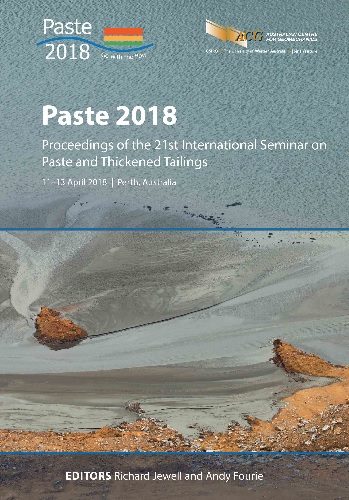Stochastic modelling of beach profiles including the influence of thickener performance

|
Authors: Seddon, KD; Pirouz, B; Javadi, S |
DOI https://doi.org/10.36487/ACG_rep/1805_20_Seddon
Cite As:
Seddon, KD, Pirouz, B & Javadi, S 2018, 'Stochastic modelling of beach profiles including the influence of thickener performance', in RJ Jewell & AB Fourie (eds), Paste 2018: Proceedings of the 21st International Seminar on Paste and Thickened Tailings, Australian Centre for Geomechanics, Perth, pp. 251-260, https://doi.org/10.36487/ACG_rep/1805_20_Seddon
Abstract:
It is generally well accepted that in the design and operation of thickened tailings storages, ‘better’ thickener performance will improve the beach profile, and thereby enhance the overall performance of the stack. Conversely, if the thickener does not perform well, it is unlikely that the designed beach profile will be achieved. The aim of this paper is to demonstrate quantitatively how thickener performance can influence the achieved beach profile in a thickened tailings scheme. The two contributing factors are: (i) solids concentration (as a surrogate for actual rheology), and (ii) throughput or flow rate. There are two considerations for each influencing factor. For solids concentration, these are: (i) does the thickener achieve the design target value, and (ii) what is the variability around this value. For flow rate, these are: (i) is the plant running at, above or below the design throughput, and (ii) what is the variability around this value. This paper presents an extension of previous work by the authors on the subject of stochastic beach profile prediction. Seddon et al. (2015) showed that the statistical variability of thickener underflow (in terms of flow rate and solids concentration) could be used in an incremental deposition model to predict realistic beach profiles. Additional statistics of actual thickener performance were presented by Pirouz et al. (2017). This paper uses a previously generated profile (Seddon et al. 2015) as a starting point, and investigates the influence of: (i) increased variability in performance (resulting in greater concavity in the profile), and (ii) an overall reduction in achieved underflow solids concentration combined with an increase in throughput (together resulting in greater concavity and an overall flatter profile).
Keywords: thickened tailings, beach profile, beach slope, stochastic modelling, thickeners
References:
Pirouz, B, Javadi, S, Seddon, KD & Williams, MPA 2014, ‘Modified beach slope prediction model for non-segregating tailings’,
in RJ Jewell, AB Fourie, PS Wells and D van Zyl (eds), Proceedings of the 17th International Seminar on Paste and Thickened Tailings, InfoMine Inc., Vancouver, pp. 31–45.
Seddon, KD, Pirouz, B & Fitton, TG 2015, ‘Stochastic beach slope modelling’, in RJ Jewell and AB Fourie (eds), Proceedings of the 18th International Seminar on Paste and Thickened Tailings, Australian Centre for Geomechanics, Perth, pp. 455–465.
© Copyright 2025, Australian Centre for Geomechanics (ACG), The University of Western Australia. All rights reserved.
View copyright/legal information
Please direct any queries or error reports to repository-acg@uwa.edu.au
View copyright/legal information
Please direct any queries or error reports to repository-acg@uwa.edu.au



